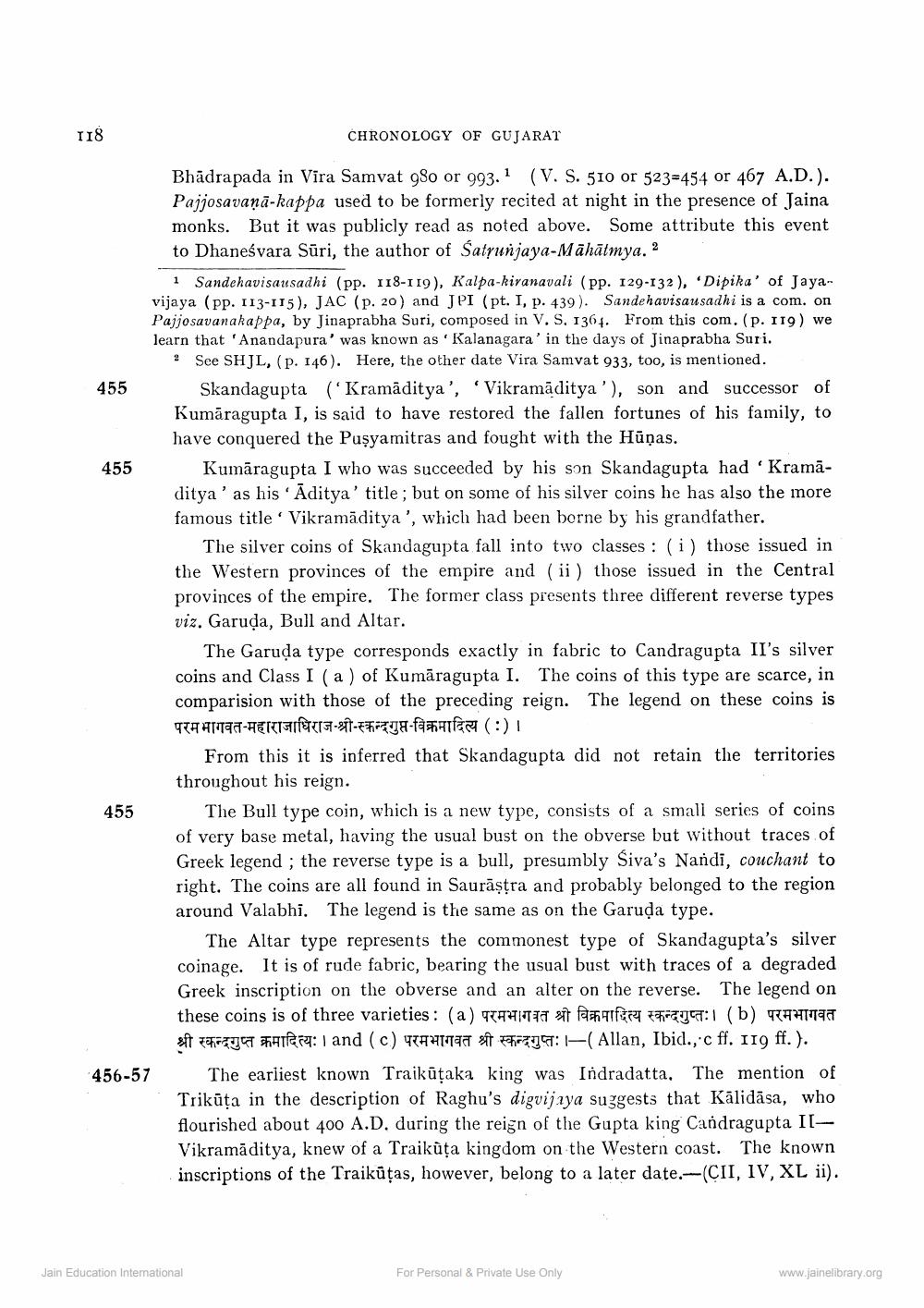________________
118
CHRONOLOGY OF GUJARAT
Bhādrapada in Vira Samvat 980 or 993.1 (V. S. 510 or 523=454 or 467 A.D.). Pajjosavaņā-kappa used to be formerly recited at night in the presence of Jaina monks. But it was publicly read as noted above. Some attribute this event to Dhaneśvara Sūri, the author of Šatyunjaya-Māhātmya. 2
1 Sandehavisausadhi (pp. 118-119), Kalpa-kiranavali (pp. 129-132 ), Dipika' of Jayavijaya (pp. 113-115), JAC (p. 20) and JPI (pt. I, p. 439). Sandehavisausadhi is a com. on Pajjosavanakappa, by Jinaprabha Suri, composed in V. S. 136. From this com. (p. 119) we learn that 'Anandapura' was known as 'Kalanagara' in the days of Jinaprabha Suri.
2 Sce SHJL, (p. 146). Here, the other date Vira Samvat 933, too, is mentioned. 455
Skandagupta ("Kramāditya', Vikramāditya'), son and successor of Kumāragupta I, is said to have restored the fallen fortunes of his family, to
have conquered the Pușyamitras and fought with the Hūņas. 455 Kumāragupta I who was succeeded by his son Skandagupta had 'Kramā
ditya' as his Āditya' title; but on some of his silver coins he has also the more famous title. Vikramāditya', which had been borne by his grandfather.
The silver coins of Skandagupta fall into two classes : (i) those issued in the Western provinces of the empire and (ii) those issued in the Central provinces of the empire. The former class presents three different reverse types viz. Garuda, Bull and Altar.
The Garuda type corresponds exactly in fabric to Candragupta II's silver coins and Class I (a) of Kumāragupta I. The coins of this type are scarce, in comparision with those of the preceding reign. The legend on these coins is परम भागवत-महाराजाधिराज-श्री-स्कन्दगुप्त-विक्रमादित्य (:)।
From this it is inferred that Skandagupta did not retain the territories
throughout his reign. 455 The Bull type coin, which is a new type, consists of a small series of coins
of very base metal, having the usual bust on the obverse but without traces of Greek legend ; the reverse type is a bull, presumbly Siva's Nandi, couchant to right. The coins are all found in Saurāṣtra and probably belonged to the region around Valabhi. The legend is the same as on the Garuda type.
The Altar type represents the commonest type of Skandagupta's silver coinage. It is of rude fabric, bearing the usual bust with traces of a degraded Greek inscription on the obverse and an alter on the reverse. The legend on these coins is of three varieties: (a) TAHITTT at fara fora UGT: (b) R 17
sit T UET ART: 1 and (c) TAHTTaa sit ZUCT: - Allan, Ibid.,'c ff. 119 ff.). 456-57 The earliest known Traikūțaka king was Indradatta. The mention of
Trikūța in the description of Raghu's digvijaya suggests that Kālidāsa, who flourished about 400 A.D. during the reign of the Gupta king Candragupta IlVikramāditya, knew of a Traikuța kingdom on the Western coast. The known inscriptions of the Traikūțas, however, belong to a later date.-CII, IV, XL ii).
Jain Education Intemational
For Personal & Private Use Only
www.jainelibrary.org




